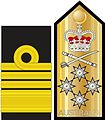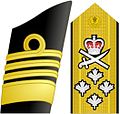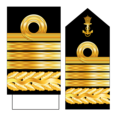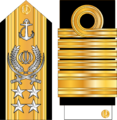Admiral
Comparative military ranks in English | ||
|---|---|---|
| Navies | Armies | Air forces |
Commissioned officers | ||
| Admiral of the fleet | Field marshal or General of the Army | Marshal of the air force |
| Admiral | General | Air chief marshal |
| Vice admiral | Lieutenant general | Air marshal |
| Rear admiral | Major general | Air vice-marshal |
| Commodore | Brigadier or brigadier general | Air commodore |
| Captain | Colonel | Group captain |
| Commander | Lieutenant colonel | Wing commander |
| Lieutenant commander | Major or Commandant | Squadron leader |
| Lieutenant | Captain | Flight lieutenant |
Lieutenant junior grade or sub-lieutenant | Lieutenant or first lieutenant | Flying officer |
Ensign or midshipman | Second lieutenant | Pilot officer |
| Officer cadet | Officer cadet | Flight cadet |
Enlisted grades | ||
Warrant officer or chief petty officer | Warrant officer or sergeant major | Warrant officer |
| Petty officer | Sergeant | Sergeant |
| Leading seaman | Corporal or bombardier | Corporal |
| Seaman | Private or gunner or trooper | Aircraftman or airman |
Talk·View | ||
| Naval officer ranks |
|---|
Flag officers |
|
Senior officers |
|
Junior officers |
|
Admiral is one of the highest ranks in some navies, and in many navies is the highest rank. It is usually abbreviated to "Adm" or "ADM". The rank is generally thought to have originated in Sicily from a conflation of Arabic: أمير البحر, amīr al-baḥr, "commander of the sea", with Latin admirabilis[1] ("admirable") or admiratus ("admired"), although alternative etymologies derive the word directly from Latin, or from the Turkish military and naval rank miralay. The French version - "Amiral" without the additional "d" - tends to add evidence for the Arab origin.
In the Commonwealth and the U.S., a "full" admiral is equivalent to a "full" general in the army, and is above vice admiral and below admiral of the fleet (or fleet admiral). In NATO, admirals have a rank code of OF-9 as a four-star rank.
Contents
1 Etymology
2 Further history
3 Admiral insignia by country
4 National ranks
4.1 Australia
4.2 Canada
4.3 Germany
4.4 Japan
4.5 Netherlands
4.6 Russia
4.7 Spain
4.8 Sweden
4.9 United Kingdom
4.10 United States
5 See also
6 Notes
7 References
Etymology
The word admiral in Middle English comes from Anglo-French amiral, "commander", from Medieval Latin admiralis, admirallus. These themselves come from Arabic amīr, or amīr al- (أمير الـ), "commander of", as in amīr al-baḥr (أمير البحر), "commander of the sea".[2] The term was in use for the Greco-Arab naval leaders of Norman Sicily, which had formerly been ruled by Arabs, at least by the early 11th century.
The Norman Roger II of Sicily (1095–1154), employed a Greek Christian known as George of Antioch, who previously had served as a naval commander for several North African Muslim rulers. Roger styled George in Abbasid fashion as Amir of Amirs, i.e. "Commander of Commanders", with the title becoming Latinized in the 13th century as ammiratus ammiratorum.[3]
The Sicilians and later Genoese took the first two parts of the term and used them as one word, amiral, from their Aragon opponents. The French and Spanish gave their sea commanders similar titles while in Portuguese the word changed to almirante. As the word was used by people speaking Latin or Latin-based languages it gained the "d" and endured a series of different endings and spellings leading to the English spelling admyrall in the 14th century and to admiral by the 16th century.
Further history
The word "admiral" has today come to be almost exclusively associated with the highest naval rank in most of the world's navies, equivalent to the army rank of (full) general. However, this wasn't always the case; for example, in some European countries prior to the end of World War II, admiral was the third highest naval rank after general admiral and grand admiral.
The rank of admiral has also been subdivided into various grades, several of which are historically extinct while others remain in use in most present day navies. The Royal Navy used colours (red, white, and blue, in descending order) to indicate seniority of its admirals until 1864; for example, Horatio Nelson's highest rank was vice admiral of the white. The generic term for these naval equivalents of army generals is flag officer. Some navies have also used army-type titles for them, such as the Cromwellian "general at sea".
Admiral insignia by country
The rank insignia for an admiral often involves four stars or similar devices and/or 3 stripes over a broad stripe, but as one can see below, there are many cases where the insignia do not involve four stars or similar devices.
Almirante
Argentine Navy

Admiral
Royal Australian Navy

Admiral
Bangladesh Navy

Almirante-de-Esquadra
Brazilian Navy

Admiral
Royal Canadian Navy

海军上将
People's Liberation Army Navy

Almirante
Chilean Navy

admiral
Croatian Navy

Almirante
Ecuadorian Navy

فريق أول
Egyptian Navy

Admiral
Estonian Navy

Amiraali
Finnish Navy

Amiraali
Finnish Navy

Amiral
French Navy

Návarchos
Hellenic Navy

Admiral
Indian Navy

Laksamana
Indonesian Navy

Daryabod (دریابد)
Imperial Iranian Navy

Daryabod (دریابد)
Islamic Republic of Iran Navy

Rav aluf (רב-אלוף)
Israel Defense Forces

Ammiraglio
Italian Navy

Kaishō[a]
Japan Maritime Self-Defense Force

Laksamana
Royal Malaysian Navy

Almirante
Mexican Navy
Admiral
Pakistan Navy

Admiral
Philippine Navy

Admiral
Philippine Navy

Admirał
Polish Navy

Almirante
Portuguese Navy

Amiral
Romanian Naval Forces

Amiral
Romanian Naval Forces

Адмиралъ
Imperial Russian Navy (1884—1904)

Адмиралъ
Imperial Russian Navy (1904—1917)

Адмиралъ
Imperial Russian Navy (1904—1917)

Адмирал
Russian Navy pre 2010

Адмирал
Russian Navy post 2010

Адмирал
Russian Navy (sleeve)

Almirante
Armada Española

Amiral
Royal Swedish Navy

พลเรือเอก
Royal Thai Navy

Oramiral
Turkish Navy

Адмірал
Ukrainian Navy

Admiral
Royal Navy

Admiral
Royal Navy

Admiral
U.S. Navy

Đô đốc
Vietnam People's Navy
National ranks
Australia
Canada
Germany
Admiral is a German Navy OF-9 four-star flag officer rank, equivalent to the German Army and German Air Force rank of General.
Japan
Post-WWII rank is Bakurocho taru kaishō or Admiral serve as Chief of Staff, Joint Staff(幕僚長たる海将) with limited function as an advisory staff to Minister of Defense (Japan), compared to Gensui (Imperial Japanese Navy) during 1872–1873 and 1898–1945,.
Netherlands
Russia
Spain
Admiral of Castile was a post with a long and important history in Spain.
Sweden
United Kingdom
United States
See also
- Comparative military ranks
Laksamana, native title for naval leaders in Indonesia and Malaysia- Ranks and insignia of officers of NATO Navies
- Nebraska admiral
Notes
^ Chief of Joint Staff of the Japan Self-Defense Forces and Chief of Staff of the Japan Maritime Self-Defense Force
References
^ "Online Etymology Dictionary". etymonline.com. Retrieved 2015-05-04..mw-parser-output cite.citationfont-style:inherit.mw-parser-output qquotes:"""""""'""'".mw-parser-output code.cs1-codecolor:inherit;background:inherit;border:inherit;padding:inherit.mw-parser-output .cs1-lock-free abackground:url("//upload.wikimedia.org/wikipedia/commons/thumb/6/65/Lock-green.svg/9px-Lock-green.svg.png")no-repeat;background-position:right .1em center.mw-parser-output .cs1-lock-limited a,.mw-parser-output .cs1-lock-registration abackground:url("//upload.wikimedia.org/wikipedia/commons/thumb/d/d6/Lock-gray-alt-2.svg/9px-Lock-gray-alt-2.svg.png")no-repeat;background-position:right .1em center.mw-parser-output .cs1-lock-subscription abackground:url("//upload.wikimedia.org/wikipedia/commons/thumb/a/aa/Lock-red-alt-2.svg/9px-Lock-red-alt-2.svg.png")no-repeat;background-position:right .1em center.mw-parser-output .cs1-subscription,.mw-parser-output .cs1-registrationcolor:#555.mw-parser-output .cs1-subscription span,.mw-parser-output .cs1-registration spanborder-bottom:1px dotted;cursor:help.mw-parser-output .cs1-hidden-errordisplay:none;font-size:100%.mw-parser-output .cs1-visible-errorfont-size:100%.mw-parser-output .cs1-subscription,.mw-parser-output .cs1-registration,.mw-parser-output .cs1-formatfont-size:95%.mw-parser-output .cs1-kern-left,.mw-parser-output .cs1-kern-wl-leftpadding-left:0.2em.mw-parser-output .cs1-kern-right,.mw-parser-output .cs1-kern-wl-rightpadding-right:0.2em
^ "Definition of ADMIRAL". Merriam-Webster.
^ Abulafia, David (2011) The Great Sea: A Human History of the Mediterranean. (London: Allen Lane).
ISBN 978-0-7139-9934-1.





































